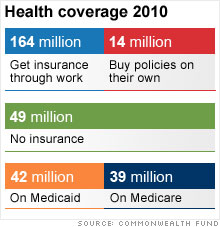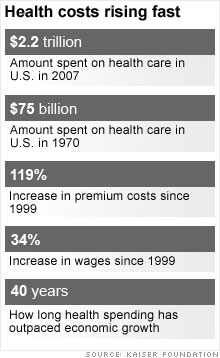Health debate: A little clarity, please
Lawmakers' self-imposed deadlines for passing health reform are near. What's not is their ability to reach consensus.


NEW YORK (CNNMoney.com) -- There's a lot of talking going on about health care reform and urgent warnings of what will happen if it doesn't pass. But for all the talk, there's very little clarity for the public about what kind of reform has a serious chance of passing and how lawmakers intend to pay for it.
The reason: Legitimate disagreement about how the country should overhaul the health care system. And it's not just between Democrats and Republicans. It's within the parties as well.
Vigorous debate is inevitable and necessary. After all, health care reform would be the biggest and most complex undertaking that lawmakers have dealt with in decades, and it would have consequences for every American.
But President Obama has set a tight deadline. He wants both the House and Senate to pass their health reform bills by Aug. 1.
So where do things stand?
Congress has come up with pieces of proposed plans with partial cost estimates and no idea how such pieces might interact with other parts of the health care system or yet-to-be-detailed reform measures. Such interactions will have a direct bearing on cost.
So far, Democrats have put out two drafts of bills. Each leaves out key details on which the reform debate will turn. With any luck, a third may be released in the next week before Congress breaks for the July 4 holiday, but that's far from guaranteed.
The latest bill -- which its authors label a "discussion draft" because they say everything is still up for discussion -- came in Friday afternoon at 852 pages. It's the product of three committees in the House that have jurisdiction over health issues.
The tricommittee House bill calls for the creation of a public plan option that would have to be self-sustaining and would have to operate under the same reform rules as private insurers. Participation in the plan by health providers would be voluntary.
Except in cases of financial hardship or religious objection, the bill would mandate that Americans have health insurance or pay a penalty based on 2% of their adjusted gross income over a certain level.
Employers would be required to "pay or play."
Companies would have to offer workers insurance that meets certain minimum requirements and pay a minimum amount of the premiums.
Or, employers that don't offer coverage would have to pay a fee based on 8% of payroll to help workers buy insurance. Certain small businesses would be exempt from the requirement and may be eligible for a new tax credit to encourage them to offer a health plan.
The House bill would also establish an insurance exchange where consumers could comparison shop for their coverage. The government would subsidize the purchase of insurance on the exchange for households making up to 400% of poverty level ($43,420 for individuals and $88,200 for a family of four).
The bill is mostly silent on one major issue: How to pay for reform, which is expected to cost in the neighborhood of $1 trillion over 10 years.
It may become clearer just how much the House would need to come up with once the Congressional Budget Office makes public its preliminary cost estimates for provisions in the bill.
Cost sparked a ruckus over the 615-page health reform bill released by the Senate Health, Education, Labor and Pension Committee a week earlier.
That Senate bill calls for the federal government to give grants to states to set up insurance exchanges. And it would offer subsidies of varying levels to help households with incomes up to 500% of poverty level. The federal government would also subsidize small businesses that offer health benefits if they have workers with low wages.
The CBO estimated just those efforts alone would cost $1 trillion and reduce the ranks of the uninsured by only a third. But CBO stressed that the estimate was incomplete because the bill left blank the sections calling for a public health plan option and did not elaborate on other elements, such as a requirement for individuals to obtain insurance.
Like its House cousin, the Senate health committee bill does not address how to pay for reform.
Also silent on that issue is the Senate Finance Committee, which had promised to put out a draft of its reform bill last week.
The Finance panel had been scheduled to mark up and vote on the bill by this coming Friday, but Chairman Max Baucus, D-Mont., postponed release of the draft amid reports that private CBO cost estimates came in considerably higher than expected.
The delay has raised questions about whether Obama's signature issue is "on the rocks" as Republicans seize on the cost issue to attack Democrats' proposals.
But one senior White House official told CNN, "We've seen this movie before: [The congressional process] looks like a total mess, nothing is getting done, and then something happens."
Even if the House and Senate manage to meet the Aug. 1 deadline for passing legislation, then the really hard work of reconciling the two bills will begin. And it again will be conducted on a tight schedule. Obama has said he wants a bill to sign in October.
Congress will be in recess for five weeks starting in August. That leaves lawmakers no more than 7 or 8 weeks to negotiate a final bill and pass it out of both chambers in time to get it to the White House before Halloween.
- CNN's Ed Henry and Deirdre Walsh contributed to this report. ![]()


